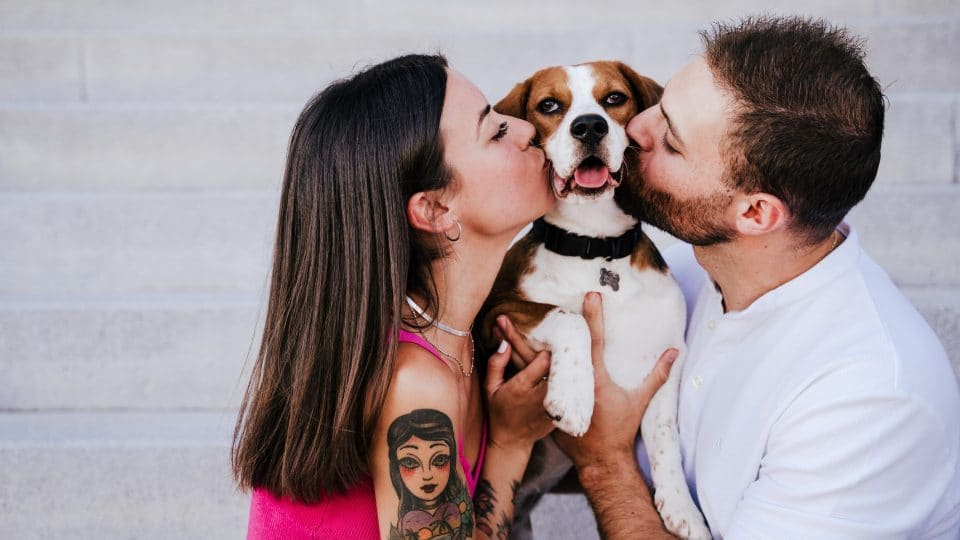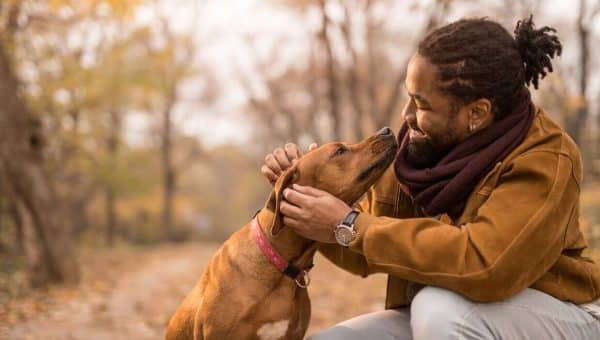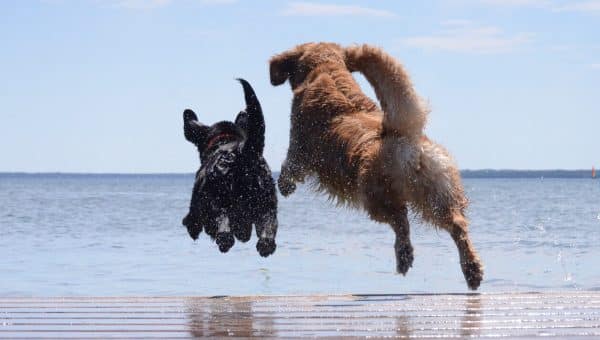You may know how to tell if your dog loves you, but do you know how to tell your dog you love them back? There are some big differences between how dogs and people show love. You may find it awkward for someone to pat your belly, but a good tummy rub can be heaven for a dog. Likewise, while a handwritten love letter can move a person to tears, dogs cannot read and have no appreciation for Shakespearean sonnets.
To get your affection across, you need to show your dog you love them in a way they’ll understand. Here are eight ways to tell your dog how much you love them just as much as they love you.
1. Talk to & Engage with Your Dog
Dogs can’t talk, but you may be surprised at how much they understand. The average dog can learn roughly 165 words – mostly terms related to their everyday life, like “dinner” and “walk.” If you say “I love you” often enough, you can absolutely make that phrase part of their vocabulary.
Praise works best when speaking to your dog. “Good girl!” works better than “Excellent canine.” If you tease your dog in a praising tone, you’re more likely to confuse them than excite them.
But your tone of voice does matter. Dogs especially love it when you compliment them in a sing-song voice. Much like human infants, dogs find the exaggerated rhythm of baby talk easier to understand.
2. Listen to Your Dog
Communication is a two-way street. Your dog’s body language and the sounds they make can tell you a lot about how they’re feeling.
For example, if your dog is enjoying a petting session, they may make happy little moans or wag their tail. But if you’re scratching your dog too hard, they may whine nervously or lift their paw at you. Signs of fear or discomfort can be subtle, so pay close attention to your dog to make sure they’re enjoying the activity as much as you are and respect their boundaries.

iStock/damircudic
3. Maintain Loving Eye Contact
Between dogs, eye contact is almost always a challenge for dominance. But between a dog and a trusted human, staring can be a sign of love. Dogs often use eye contact to communicate with their humans, whether it’s to check how you’re feeling or ask for food.
When you and your dog maintain eye contact, both of you get a boost in oxytocin. This hormone strengthens social bonds and lets your dog literally “feel the love.” Long gazes (over one minute) boost your dog’s oxytocin more than short glances.
4. Pet Them Often
Dogs often express their love by leaning on you. However, most dogs aren’t large or sturdy enough to let you fully lay on them in turn.
“Dogs that lean on you typically don’t want to be leaned back on, per se. Instead, they are just very into tactile stimulation and love touching a loved one,” says Russell Hartstein, a dog behaviorist at FunPawCare.
A good petting session gives your dog a loving touch without crushing them. The best petting spots are usually their head and tummy. A gentle scratch behind the ears will make almost any dog happy.
5. Prioritize Cuddles & Sleeptime
Dogs evolved as pack animals whose members often rest together. When you invite your dog to nap on the couch or sleep on your bed, you’re showing your love for them and consider them a part of your family.
Research on free-ranging dogs (those living without humans) suggests dogs are less relaxed when they sleep alone than when they sleep with others. When a dog sleeps solo, they have to keep one eye open in case a predator or evil vacuum cleaner sneaks up on them. It’s harder for an enemy to ambush multiple dogs, which means a cuddle pile is safer as well as cozier.

iStock/Lazy_Bear
6. Play on Their Terms
Dogs often wrestle or chase each other as a peaceful way of establishing a hierarchy and blowing off steam. With humans, their drive to play is less about competition and more about communication and bonding. You playing with them shows you’re strengthening that bond and loving them.
Additionally, games are fun and help your dog understand your expectations and boundaries. For example, if your dog tackles you during tag, and you stop playing, they’ll likely be gentler next time so they can play longer. This sort of knowledge can be very helpful during dog training.
For most dogs, whether they win or lose a game matters less than the fact that they have your full attention. That said, it couldn’t hurt to give them a victory every once in a while.
7. Stay Active
We love exercise, and turns out our pups do too! It’s well known that most dogs love walks. They enjoy exploring the world with you, whether you’re collecting neat sticks or helping them mark your pack’s territory. If you want a greater challenge and more active time, try hiking, swimming, or another form of exercise with them.
You can tell if your dog feels a connection if the two of you move in sync. For instance, they may move when you move, stop when you stop, and look where you’re looking. A 2017 study found dogs often match their human’s movements even when off-leash, and they usually preferred to stay close to their human.
Signs of Affection Your Dog May Not Like
Not all forms of affection translate well between species. How you show your dog you love them might end up having the opposite effect if you’re not careful. Your dog may find some gestures downright unnerving. In general, dogs don’t enjoy the following.
- Kissing: Dogs may see a peck on the cheek as a toothless attempt to nip them. Nips are small, gentle bites used to tease pack members or show dominance. Be warned: your dog may respond to your kiss with a much toothier form of play, like biting.
- Hugging: Circling your arms around your dog in a hug can make them feel trapped. This is especially true if you and your dog are still getting to know each other.
- Paw Massage: Many humans see foot massages and pedicures as a pampering experience. But dogs’ feet have a lot of delicate nerve endings and blood vessels. Letting anyone handle their paws, no matter how gently, is often stressful.
That said, there are exceptions. “Different dogs have different love languages,” Hartstein says. If your dog does happen to enjoy hugs and kisses, it’s fine to give them the kind of affection they crave.

iStock/AJ_Watt
Does Your Dog Know You Love Them?
You may fall in love with a puppy at first sight, but a new dog won’t realize how much you care overnight. Even the friendliest dogs need time to bond after adoption.
Hartstein says a dog can take three days to feel safe in their new environment. By three weeks, they can start trusting you and developing affection.
You can tell your dog is accepting your love if they:
- Return your gaze
- Cuddle or lean on you
- Share their toys with you
- Ask you to play
- Have loose, relaxed body language around you
- Act excited to see you
“After three months, the dog generally understands that the humans are the parents, the home is theirs, and much more love and bonding can flourish,” Hartstein says.





